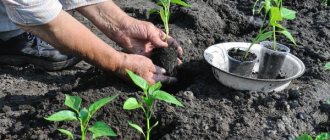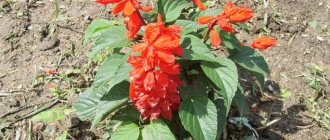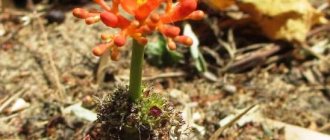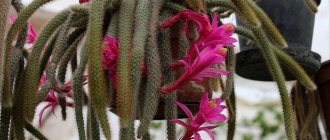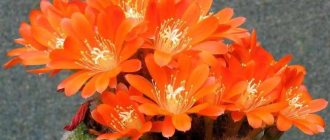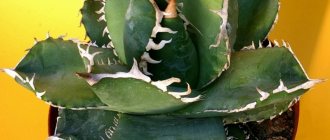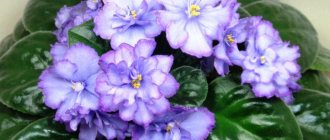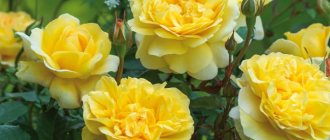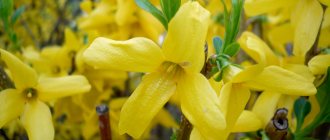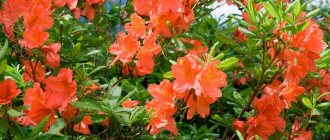Sage (lat. Salvia) is a tall perennial herbaceous plant, less commonly a shrub up to 0.75 m tall. Belongs to the Lamiaceae family. This group is characterized by a developed rhizome, a sinewy branched stem and abundant flowering all summer. The flowers are collected in erect arrow-shaped inflorescences - racemes. Different types of sage have found application in medicine, landscape design, cooking, aromatherapy and other areas of human life.
Description of flowering plants of the genus Sage
Salvia belongs to the Lamiaceae family. In addition to its culinary properties, this plant is used in garden decoration and its medicinal properties are also well known. There are nearly 1,000 species and cultivars of shrubs, herbaceous perennials and annual herbs in the Salvia genus worldwide, including the two well-known plants Salvia officinalis (Common sage) and Salvia rosmarinus or Rosemary (formerly Rosmarinus officinalis). Salvia is distributed on all continents.
The common modern name Salvia comes from the English sawge, which was borrowed from Old French sauge and Latin salvia. In everyday life, Sage is usually called the culinary plant Salvia officinalis (“Common Sage”). Ornamental species are usually referred to by the generic name Salvia. All Salvia species include perennials, annuals, semi-woody subshrubs, tall plants and groundcovers.
As a rule, most Salvia species have strong stems, the average height of which is about 1.5 meters. The leaves are usually entire, but sometimes serrated or pinnately divided. Flowering stems produce small bracts, unlike basal leaves - in some species the bracts are quite showy.
Flowers are formed in racemes or panicles; their coloring can vary depending on the species or variety: from blue to red, sometimes white and yellow. Salvias bloom from late spring to fall, with some blooming a little earlier and others blooming later.
The fruits are smooth, can be ovoid or oblong nuts, and in many species they are covered with a shell.
Description
According to Wikipedia, sage ( Latin name - Salvia) is a herbaceous perennial subshrub of the Lamiaceae family. Medicinal species have found recognition in scientific and traditional medicine, cosmetology, cooking, perfumery, and decorative ones - in landscape design.
Other name
In addition to the traditional name, sage is called noble, cross, royal, or, based on Latin, salvia. In everyday speech in different areas you can hear: honey honey, blue letter, kokish, samose, lettuce leaf, salvia. On English-language packaging it is designated as garden (common) sage.
Where and how does it grow
The habitat of wild salvia is the Mediterranean, especially Italy, Serbia, and Albania. The shrub is actively cultivated in the southern steppe regions of Russia, in the territories of Slovakia, the Czech Republic, France, Greece, Moldova, and Ukraine.
The crops are heat-loving, drought-resistant, but defenseless against frost. They reproduce by dividing the bush or by seeds. If planted in spring, the first harvest can be harvested from the end of August.
What does it look like
The average height of a sage semi-bush is 70-75 cm. The rhizome is densely branched, the stem is bare woody below, herbaceous above, the leaves are green with a grayish tint, elliptical, petiolate or sessile, the inflorescences are spike-shaped, the flowers are usually light lilac, lilac-blue or blue.
photo
salvia flower photos
Chemical composition
Salvia is valued for its content:
- vitamins (A, group B, C, E, K, PP);
- essential oil containing cineole, thujone, borneol, and other terpenes;
- flavonoids (plant polyphenols that activate enzymes);
- bitterness;
- phytoncides;
- tannins;
- organic acids (ursolic, oleanolic, chlorogenic);
- micro-, macroelements (potassium, calcium, sodium, magnesium, iron).
There is a species of sage that causes a hallucinogenic state. The ancient Gauls used it in rituals of communicating with spirits.
What smells
The plant itself does not emit a strong aroma. But if you rub the leaves between your fingers, a sharp, specific smell . Reminds me of something between lavender and tobacco with a hint of camphor.
Benefit and danger
Salvia has a whole range of beneficial effects:
- antimicrobial;
- anti-inflammatory;
- antiseptic;
- astringent;
- expectorant;
- hemostatic;
- diuretic;
- calming;
- restorative.
It is used to treat diseases of the gastrointestinal tract, respiratory system, colds, and to combat gynecological and reproductive problems. Read more about the positive effects on the human body in the following sections.
Among the many varieties, there are toxic plants . Therefore, if you lack experience and knowledge, you should refrain from independently procuring raw materials in order to avoid possible poisoning.
Planting and caring for Sage in the garden
Salvia can be planted in a garden bed or in a flower garden; it is often grown at home by planting it in pots. Let us dwell in more detail on the requirements of this herbaceous flower when grown in open ground.
Where is the best place to plant Salvia or Sage?
An ideal place to plant a plant in the garden is where onions, cabbage, potatoes or legumes previously grew.
You also need to take into account the lighting requirements of Sage:
- all Salvias grow in full sun;
- many ornamental varieties (usually with light flowers) also do well in partial shade, but their flowering will be weaker;
- The ideal location for the landing site would be on the south side;
- Salvias look great when planted in groups of three or more.
Suggested places for planting ornamental varieties are flower borders and flower beds, patios.
When is the best time to plant Salvia?
The most optimal period for planting flower seedlings will be early spring, after the end of frost. Seeds can be sprouted indoors by sowing them in a container 6-8 weeks before the last frost, and planting the seedlings after the threat of freezing temperatures has passed.
You can also sow Salvia seeds directly into open ground in May or August.
You can also sow Sage seeds directly into the soil in the fall (the later the better) so that they cannot germinate before the onset of frost. This way they will overwinter well, and in early spring they will begin to sprout new shoots.
Soil requirements
Where you plant your Salvia seedlings will depend on the species and variety. Sage loves well-drained soil most of all. Garden soil of average fertility is suitable for most plant varieties.
When planting in pots, use a mixture of regular garden soil and perlite. This allows the water to drain quickly.
You might be interested
Ornamental grass Fine feather grass
Review of the best ornamental grasses for garden decoration
Japanese grass Hakonechloa large
How to plant Salvia flower seedlings in open ground
First you need to prepare a place for planting:
- Loosen the soil to a depth of 30 cm, removing any large stones or weed roots.
- Mix the soil with humus or potassium-phosphorus fertilizers to provide it with nutrients.
Further actions will not be difficult:
- dig a hole twice the diameter of the pot in which the plant is located;
- remove the seedling from the container and place it in the hole so that the upper part of the root ball is flush with the soil surface;
- the distance between plants is from 30 to 90 cm, depending on the variety;
- fill the voids around the roots of the plant with soil and compact them carefully;
- Water the planting site thoroughly and mulch.
Remember - the Salvia flower is capable of cross-pollination, so different varieties need to be planted far from each other.
You can learn more about planting Salvia seeds for seedlings and planting seedlings in open ground from this video.
Treatment
People have many recipes for all occasions.
There is no single remedy that is made from sage and used to treat “everything at once.” The plant has many properties, and in order for one or another of its methods of action to manifest itself, each disease requires its own recipe.
Let's consider ways to use sage for the treatment and prevention of certain diseases:
Local external treatment
In cases where it is necessary to treat some external problem areas, you can use a decoction of sage herb . These can be wounds, abrasions, inflammation, hemorrhoids, etc.
The extract is prepared as follows:
- In a small resealable container, mix 250 ml of water and 2 tablespoons of sage herb
- Place the container in a water bath for 15 minutes
- cool the broth for 45 minutes
- pour the broth into a container, squeeze out the rest and add boiled water to 250 ml
The decoction can be stored in the refrigerator for 24 hours. Warming before use is required. In addition to compresses and lotions, a similar composition is also used for gargling and mouthwash.
Local internal processing
Internal use requires slightly lower concentrations of active substances so that they do not irritate more delicate surfaces and mucous membranes.
In this case, not a decoction of sage is used, but an infusion:
- A tablespoon of sage herb is poured into 250 ml of boiling water and infused under the lid for 30-45 minutes.
- The container can be additionally wrapped in any heat insulator.
- The infusion is also stored for no more than a day and is heated before use.
- The infusion is used as maintenance therapy for stomach diseases, bronchitis, and tracheitis.
- The dosage for the diseases in question ranges from 10 to 60 ml 4 times a day before meals.
Prevention of various diseases with extract
The short shelf life of decoctions and infusions creates many problems if it is necessary to take long courses of taking the active substances contained in sage.
And sometimes there is an urgent need for this, for example, during the cold season it would be nice to take some preventive measures.
In such a situation, you can prepare a sage extract based on ethyl alcohol.
It can be purchased at a pharmacy, or you can prepare it yourself. If ethyl alcohol is not on hand, you can use regular vodka without dyes and flavors.
For this we take:
- three tablespoons of sage herb
- which are poured with 500 ml of vodka and mixed thoroughly
- then the container is closed with a lid and placed in a dark place for further infusion
- infusion time is about 2 weeks
- this involves daily mixing and shaking of the liquid
- the liquid is filtered, squeezed out and placed in a cold place in a tightly closed container
- used as a prevention of colds, 1 teaspoon per day after meals
A similar extract is also recommended for the prevention of atherosclerosis in the same dosage. You can dissolve a teaspoon of extract in a glass or mug of tea.
Sage extract
Industrially, various lollipops and throat lozenges are produced from sage extract. It is not recommended to do this at home, since prolonged contact of the sage extract obtained in this way with mucous membranes can cause irritation or burns.
Essential oil
It is quite difficult to prepare it at home, since it requires a rather complex device for distillation and filtration.
However, this oil is quite widespread and can be purchased in pharmacies or cosmetic stores.
Essential oil is not suitable only for external use and its main function is cosmetic.
It helps to cope with local skin problems such as the effects of acne, microcracks and swelling. The oil is applied to damaged areas of the skin using cotton swabs.
It is also used in aromatherapy, since sage essential oil has the ability to relieve stress and tension.
The oil is quite concentrated, so it is enough to dilute 1-2 drops in half a teaspoon of water in a cup of aroma lamp. This aromatherapy will additionally have a preventive nature, since the oil is an antibacterial agent.
Lotions and compresses based on essential oil are made according to the following scheme:
- 5-10 drops of essential oil are dissolved in 100 ml of water and tampons are soaked in the resulting composition
- then tampons are applied to the affected areas for bruises and hematomas
- compresses can also be applied to painful joints
Use for menopause
Sage is rich in natural estrogens, which are female sex hormones.
Traditional medicine in some countries calls it “female herb”
Menopause is a difficult period in a woman’s life, since the hormonal balance is disrupted and the functioning of all body systems is carried out under stress.
Therefore, the use of sage during menopause helps women significantly alleviate this difficult period.
To improve well-being during menopause, it is necessary to use an infusion of dried leaves of the plant.
To make this infusion:
1 you will need to boil 500 ml of water
2 into which 1 tablespoon of crushed dried sage leaves is poured
3 cover the container and leave for 30 minutes, then strain
4 Take a tablespoon 3 times a day before meals
5 infusion is stored in the refrigerator, shelf life is 3-5 days
6 It is not necessary to heat before use
The use of essential oil also helps with menopause. In addition to the standard aromatherapy procedure, you can use sage essential oil while taking a bath.
For this:
- add 10-15 drops of essential oil to the collected bath
- after that you just need to lie in it for 10 minutes, relaxing and doing nothing
Since we are talking about baths, you can take sage baths 2-3 times a week during menopause.
For this:
- Before taking a bath, you need to boil a 3-5 liter pan of water
- you need to pour half a pack of sage herb from the pharmacy into it, letting it boil for 2-3 minutes
- then let it sit for another 5-10 minutes and pour the entire contents of the pan into the bathroom
- It is recommended to stay in a sage bath for no more than 15 minutes - this time will be quite enough for relaxation and saturation of the body with a sufficient amount of hormone
An interesting option for a bath would be to use bath bombs containing sage extracts and essential oils.
They are instant balls that contain a whole range of necessary substances. Often these "bombs" include dry grass and plant flowers. Sometimes they consist of extracts of several herbs.
As a stimulant of reproductive function
Modern research, having discovered natural analogues of tarragon in sage, has confirmed this assumption. Therefore, doctors recommend products containing sage as a side therapy for infertility.
Back in the 16th century, doctors recommended sage as a natural aphrodisiac and a means of increasing female fertility.
For these purposes, it is recommended to take sage at the beginning of the menstrual cycle, more precisely from the 5th day before the start of ovulation. If menstruation is absent for a long time, then taking it should be started on any day, approximately corresponding to the 5th day of the cycle.
In this case, the infusion is prepared according to the following scheme:
- 1 tablespoon of dry sage leaves is poured into 250 ml of water, brought to a boil.
- infuse for 15 minutes
- after this the infusion is filtered
- taken 3-4 times a day, half an hour before meals
- Every day you need to make a new infusion
If you are taking hormonal medications, you should not take sage. In addition, since sage is not recommended to be taken for more than three months, the entire course of taking it should not exceed more than 3 menstrual cycles. The subsequent course can be carried out no earlier than two months after the end of the previous one.
The use of sage for the treatment of infertility must be agreed with your doctor! It is also important when treating infertility to monitor the body’s reaction to sage. In case of any deterioration or appearance of allergies, the drug should be stopped immediately.
Mouth rinse
Since sage is a good anti-inflammatory agent, its decoction is recommended by doctors for rinsing the mouth in case of various types of infections. The complex effect of the decoction reduces pain at the site of inflammation, relieves swelling and prevents the development of the inflammatory process.
Indications for the use of sage decoction include stomatitis, gum disease and gumboils. In addition, sage is indicated after tooth extraction
Sage is also effective for various diseases of the upper respiratory tract: tonsillitis, pharyngitis and tonsillitis.
1 gargling is done up to 6 times a day
2 the temperature of the decoction should be between +35°C and +38°C
If you start rinsing at the very beginning of the disease, this will reduce pain throughout its entire duration and will contribute to a speedy recovery.
Inhalations
To carry out inhalations, take a tablespoon of dry herbs or sage flowers and add 500 ml of boiling water. After this, the resulting mixture is boiled for another five minutes, and then left under the lid for the same amount of time.
You need to breathe sage vapor for 5-7 minutes, while avoiding burns to the mucous membranes of the nose or throat.
Indications for the use of inhalations are infectious diseases of the throat or bronchi
The following technique is sometimes used:
- water is boiled indoors (most often in the kitchen) in a medium-sized container
- after that, 5-6 tablespoons of dry sage are poured into it and left to boil with the lid open
- Several people in need of inhalation are invited into the room at once and remain in it for 10-20 minutes
- thus, their respiratory tract is exposed to sage vapor at almost room temperature
- an increased duration of such an inhalation procedure is necessary to ensure a therapeutic effect
The disadvantage of this technique is the increased air humidity in a closed room at the end of the procedure, but you can get rid of it by simply ventilating it.
As a skin care product
Sage is widely used as a skin care product and treatment for skin diseases.
These include:
- burns and frostbite
- psoriasis, eczema
- purulent and long-lasting wounds
- consequences of acne
- eczema
Decoctions and infusions of sage reduce inflammation and eliminate unpleasant burning and itching. They cleanse the skin pores and stimulate its regeneration processes.
Sage is one of the few plants that is recommended for facial skin care. Based on it, many different medical and cosmetic products are made to care for diseased and problematic skin.
Sage based cleansing cream
Many skin care treatments can use sage-based products, both store-bought and homemade.
A mask for dry skin can be made as follows:
1 tablespoon of oatmeal or finely ground flakes mixed with a tablespoon of yogurt or sour cream
2 add 2-3 drops of sage essential oil to the resulting mixture, then apply the resulting mask to the skin of the face
3 after 10-15 minutes, the mask is removed and the face is washed with warm water
To care for oily skin, a tonic consisting of sage leaves and flowers is recommended:
1 tablespoon of leaves is poured into 100 ml of boiling water
2 as soon as the broth has cooled, add 100 ml of apple cider vinegar
3 Wipe your face with the resulting mixture twice a day - morning and evening
The tonic will keep in the refrigerator for 2 weeks.
You can fight acne in the way described earlier - by applying essential oil to areas of problem skin using cotton swabs or sticks.
Application for hair
Salvia decoctions and infusions can also be used to care for hair and scalp, but their concentration will be slightly different than when treating wounds and inflammations.
Products based on salvia stimulate hair strengthening, relieve inflammation of the scalp, reduce oiliness of both skin and hair, and also lead to a reduction in the amount of dandruff.
Typically, decoctions of the plant are used to rinse hair after shampooing.
When creating such decoctions and infusions, you can use both fresh and dried leaves or flowers. To do this, a glass of uncrushed leaves is poured with 1-2 liters of water brought to a boil and infused for an hour. After this, it is filtered and the broth is ready for rinsing.
Rinsing is performed as standard:
1 washed hair and scalp are doused with decoction several times
2 are then wrapped in a towel and kept under it for 5-10 minutes
3 then you need to wash off the remaining broth from your hair
4 salvia has the ability to stain clothes, so you need to wash your hair thoroughly
Essential oil is used to stimulate hair growth and strengthen it. The mixture for hair roots is made as follows:
1 to 10 ml of olive oil add 3 to 5 drops of essential oil
2 then this mixture is applied to the hair roots
”3″
Further care for Sage (Salvia) in the garden
Salvia does not require regular care. It does not need special conditions for growth; the most important thing is to weed in time to remove weeds and loosen the soil. It is also worth knowing about other necessary procedures that you should pay attention to.
Watering
It is necessary to moisten the soil in the hot summer if the amount of precipitation is less than 3 cm per week. Salvia does not like excessive watering.
Some types of Salvia are more demanding of moisture.
Top dressing
If during planting you have sufficiently enriched the soil with organic matter, you should not apply fertilizers in the future. The flower will feel the seed perfectly without additional feeding.
Trimming
Remove dead stems from perennial plants. In some species of Salvia, the lower stems become woody with age. Feel free to trim them, leaving about ten centimeters above the ground. Also, after the first frost, cut the stems 5-7 cm above the soil level.
Pruning is also important to encourage re-blooming. However, if you want to collect the seeds, leave a few buds to dry naturally on the plant. Collect the seed pods and shake them into a bag or jar.
Pruning after flowering helps maintain a better, bushier shape and stimulates the Salvia.
Harvesting Sage
The leaves and flowers of Common Salvia can be collected for culinary purposes at any time. Preference is given to young leaves that have a brighter taste. Excess leaves and flowers collected can be dried or frozen. Freezing is the best option for preserving foliage collected in midsummer.
The first year after planting Salvia, harvest by only lightly trimming a few leaves at a time. After the first growing season, harvest the plants freely. You can cut individual leaves or 15 to 20 cm of green stem with leaves. It is better to collect leaves before flowering.
What does it help with?
The range of exploitation is wide: from superficial lesions, mechanical damage to serious illnesses.
Diseases
Sage-containing products are indicated for:
- diseases of the oral cavity, throat ( toothache , stomatitis, sore throat);
- problems with the gastrointestinal tract (ulcers, gastritis );
- diseases of the respiratory system ( bronchitis , pneumonia);
- cold;
- hemorrhoids;
- initial stage of diabetes mellitus;
- skin rashes (dermatitis, acne, psoriasis);
- cuts, frostbite, burns;
- reduced immunity;
- chronic fatigue;
- menopause;
- infertility.
For a severe cough, a glass of milk boiled for five minutes with a teaspoon of herbs will help. The slightly cooled drink is drunk in small sips at a time.
Weight loss
Due to several properties, sage is recommended for losing excess weight. It dulls the feeling of hunger, while simultaneously charging you with energy, removes toxins, blocks free radicals, speeds up metabolism, regulates bowel movements, relieves flatulence, and helps reduce cellulite.
The dried or fresh plant is used to season dietary foods and smoothies. But a more noticeable result will come from drinking the decoction in the course (no longer than 3 months in a row).
To do this, pour a tablespoon of dry collection or a handful of fresh leaves with a glass (250 ml) of clean water and heat for 15 minutes in a water bath. Then leave covered for another 20 minutes and strain. Drink half a glass before main meals. It is allowed to occasionally diversify the drink with a slice of lemon, honey, or a piece of ginger. Before taking a long time , it is advisable to consult a doctor.
Now you know what benefits and sometimes harm Salvia officinalis can bring.
Sage propagation
A gardener can take cuttings of the perennial Salvia flower in spring or early fall.
Some species often reproduce themselves, so you may find young seedlings in your flowerbed that can be used in other parts of your garden.
How to cut Salvia?
- Before the flower buds appear, take stem cuttings from vegetative (non-flowering) branches about 10cm long. Remove the lower leaves and cut each cutting just below a node.
- Place them in a pot with pre-moistened soil. Cover the pot with a clear plastic bag - try not to let the bag touch the foliage.
- Place the container in a cool greenhouse and shade it to prevent burns from strong sunlight.
- After three weeks, the cuttings will be ready to be transplanted to a new location.
Meadow sage (Salvia pratensis)
It has very long loose branching purple-blue inflorescences up to 40–50 cm, the height of the bush is 50–80 cm. It blooms for a long time - from mid-June to late autumn. From the second half of July, flowering weakens a little, but in September a new wave begins.
Meadow sage
Diseases and pests of Salvia flower
Despite the fact that Sage has insecticidal properties and is considered a spicy medicinal plant, due to frequent watering it can be damaged by mold. In this case, the affected areas must be treated with a liquid sulfur mixture.
Pests and diseases are rarely a problem for Salvia. The most common problems in caring for Salvia flowers can arise from aphids, spider mites, and whiteflies. You can get rid of pests using folk remedies or insecticides.
You may also encounter diseases such as Powdery Mildew, Root Rot and Botrytis.
Chemical composition and nutritional characteristics
Since this herb is generally not consumed in large quantities, it is difficult to consider it as a source of calories, carbohydrates, fat, protein or fiber. But sage can serve as a good source of other equally beneficial substances for the body.
This herb contains many essential oils, flavonoids, and phenolic compounds.
In total, these are more than 20 useful components, most of which have antioxidant properties. Sage is known for its amazing combination of essential oils containing ketane, alpha and beta thujone. Compounds such as cineole, borneol, chlorogenic, fumaric, caffeic and nicotinic acids were also found in the greenery of the plant. Nutritional value per 100 g of dry herb
| Calorie content | 315 kcal |
| Carbohydrates | 60.73 g |
| Squirrels | 10.63 g |
| Fats | 12.75 g |
| Cellulose | 40.3 g |
| Vitamin B1 | 0.754 mg |
| Vitamin B2 | 0.336 mg |
| Vitamin B3 | 5.72 mg |
| Vitamin B5 | 2.69 mg |
| Vitamin B9 | 274 mcg |
| Vitamin A | 3.5 mg |
| Vitamin C | 32.4 mg |
| Vitamin E | 7.48 mg |
| Vitamin K | 1.71 mg |
| Sodium | 11 mg |
| Potassium | 1070 mg |
| Calcium | 1652 mg |
| Copper | 0.757 mg |
| Iron | 28.12 mg |
| Magnesium | 428 mg |
| Manganese | 3.133 mg |
| Zinc | 4.7 mg |
Application of Salvia in landscape design
Despite its fame as a culinary plant, landscape designers often use Salvia in the garden. You can create unusual flower arrangements from different types and varieties. The most commonly used variety is the nutmeg variety. However, to improve the spice bed, tandems with Mint or Basil, Rosemary or Thyme, Oregano and Hyssop are mainly used.
How else can you use Sage in garden decoration?
- The variety of colors, sizes and long flowering periods make Salvia an ideal addition as a border plant.
- Sage pairs well with plants with brighter foliage and larger flowers.
- Some species bloom late and beautifully brighten the autumn palette, extending the flower season.
- In large flower pots, low-growing Salvias serve as fillers of empty spaces or drape the edge of the pot; taller species can be the centerpiece of the composition.
- Salvias attract butterflies and other pollinators and make great additions to nature-style gardens.
History of origin and use
Sage is native to Mediterranean countries and has been used in these regions for thousands of years. In addition, this herb has one of the longest history of use in medicine. The ancient Greeks and Romans highly valued the healing properties of sage. The Romans treated it as a sacred plant and even created a special ceremony around the collection of the herb. These cultures also used sage as a meat preservative. Ancient cooks believed that this herb slowed down the spoilage of food. And now this fact has received scientific confirmation. Researchers have found a large number of terpenes in sage, which, in fact, work as preservatives.
In addition, throughout history, sage has enjoyed the fame of a magical plant. Arab doctors in the 10th century considered it a plant of immortality; Europeans in the 14th century used the herb to protect against witchcraft. The Chinese also valued this plant. But in the east, sage was used primarily as a delicious tea.
Medicinal properties of Sage
Salvia vulgare (or Salvia officinalis) is the source of many healing properties. It has a soothing, antibacterial, anti-inflammatory and antimicrobial effect. Sage is used as a natural cleanser and pesticide.
- This aromatic herb contains caffeic acid, chlorogenic acid, rosmarinic acid, ellagic acid, and rutin, all of which play important roles in its health benefits.
- Sage contains more than 160 different polyphenols, plant-derived chemical compounds that act as antioxidants in the body.
- One study found that drinking 1 cup (240 ml) of Sage tea twice daily significantly increased antioxidant protection. Salvia drink also reduces the amount of “bad” cholesterol and also increases the level of “good” cholesterol.
- Sage has antimicrobial properties that can neutralize germs that contribute to plaque formation.
- Salvia may help reduce the intensity and frequency of menopausal symptoms such as
- hot flashes and irritability.
- Fresh Salvia leaves are a traditional remedy for diarrhea. Research has shown that
- The plant contains compounds that can relieve diarrhea by relaxing the intestines.
- Salvia leaf extract has been shown in humans to lower blood sugar and improve insulin sensitivity.
- Several animal and test-tube studies have shown that Salvia may fight certain types of cancer, including oral, colon, liver, cervical, breast, skin and kidney cancers. So far, these studies have not been conducted in humans.
Useful properties and contraindications
Sage of fortunetellers - what kind of plant, description, where it grows
You can buy dry sage leaves at a pharmacy or grow them in your country house. The product will help if you use it according to the instructions. Irrational use can cause harm.
The leaves of the plant have analgesic and diuretic effects. The herb extract helps in the treatment of acne and acne, and has a pronounced anti-inflammatory effect.
Meadow sage
Preparations based on medicinal sage are effective for arthritis and rheumatism. Sage is also famous for increasing blood pressure.
Indicated for use in cases of nervous tension as an excellent alternative to antidepressants.
Note! Using sage decoctions, it is possible to alleviate the menopause; it is actively used in gynecology. Sage extract has a pronounced hemostatic effect.
Sage is contraindicated during pregnancy. During breastfeeding, it may help reduce the amount of milk produced. Sage is also contraindicated for hypertension, epilepsy and nephritis. An allergic reaction may develop.
Varieties of Sage or Salvia
We list the most common types of plants.
Salvia officinalis
The most famous culinary plant from the genus Salvia. This perennial plant with woody stems reaches a height of about 50-70 centimeters. It is often grown in gardens with other herbs as an ornamental plant in flowerbeds or rock gardens.
Photo of Salvia officinalis
The greyish-green leaves, the surface of which is covered with fluff, are thin and elongated in shape. The flowers are blue and bloom in the form of spikes. It is used in medicine and cooking, and is also used in cosmetology.
Clary sage (Salvia sclarea)
Perennial or annual crop. Despite the fact that the plant is medium-sized, sometimes there are meter-sized specimens.
Clary sage (Salvia sclarea)
It is distinguished by lush buds of a dark purple color.
Meadow sage (Salvia pratensis)
Woody perennial plant with wrinkled oval leaves up to 20 cm in length and erect stems with long violet-blue, rarely pink or white spines, flowers 2-3 cm long, in early and mid-summer. It reaches a height of 80 centimeters.
Grows in light, moderately fertile, humus-rich, moist but well-drained soil. Does best in full sun, but can tolerate light partial shade.
Salvia splendens
Another name for the species is Salvia brilliantis. A compact evergreen perennial up to 45 cm tall and up to 30 cm wide. Numerous cultivars are available in garden centers, ranging in color from the traditional red to purple and white.
This Salvia blooms continuously from spring to autumn. The flowers are formed on spikes and are two-lipped. The leaves are light to dark green, elliptical, serrated. The foliage is fragrant when crushed.
Oak sage (Salvia nemorosa)
Also known as purple sage, it is a perennial plant that blooms in various shades of purple and lavender from June to September.
Oak sage (Salvia nemorosa)
These vigorous herbs have spear-shaped leaves and many purple-blue spines. Many gardeners trim fallen flowers (or trim them with pruning shears), but sometimes they bloom all summer long even without pruning. Removing fallen flowers will keep the plant looking tidy. The flowers are purple with a blue tint, shaped like a spike, and reach a height of 70 centimeters.
Blue sage (Salvia azurea)
It has pale blue inflorescences and many small flowers.
Blue sage (Salvia azurea)
Flowering starts in July and lasts until October. Enjoys the greatest success among gardeners.
Salvia divinorum
Another name for this flower is Sage of fortunetellers or narcotic. This species is known for producing the psychoactive hallucinogen salvinorin A from its leaves.
In nature, Salvia divinorum is found in a small area in the mountains of Central America. In most European countries, breeding and growing this plant is prohibited by law.
The article uses materials from the resources: almanac.com and healthline.com
Marcus
Breeders classify this variety into a separate dwarf group. The bush barely reaches 20 cm in height. The stems are erect and grow in breadth and height. Therefore, in appearance, Marcus resembles a ball. The flowering shrub looks especially impressive. Inflorescences of bright blue or purple color are collected in spikelets. The flowering period lasts all summer.
Marcus is unpretentious, loves well-lit areas and infrequent watering. It is used by florists and landscape designers. Easy care combined with a beautiful appearance make Marcus a stylish addition to any composition.
Use in cooking
Sage can be eaten fresh or dried. It goes well with tomato sauce, omelettes, and frittatas. Italians add this spice to pizza. Sage also serves as a good addition to salads, baked chicken, fish, and pork. Thanks to its specific aroma, sage goes well with seafood. But this spice should be added at the end of cooking, so the herb will retain more of its beneficial properties.
Sage is not just a spice, widely used in various national cuisines. This medicinal plant has a powerful effect on the body. Sage is one of the best remedies with anti-inflammatory, antimicrobial, and antioxidant properties. Tea from this plant can truly replace a huge amount of “chemistry” that is more familiar to us. It is not for nothing that several thousand years ago the Chinese drank tea from it as a remedy against aging and heart disease.
How to select and store
Whenever possible, it is better to choose fresh sage greens over dried herbs, as they have better flavor. Fresh leaves have a rich green-gray color. For tea or preparation, it is better to take leaves without dark or yellow spots.
Fresh greens can be stored in the refrigerator, wrapped in a damp paper towel and placed in a plastic container or glass of water. Dried sage is stored away from moisture and direct sunlight.
More fresh and relevant information about health on our Telegram channel. Subscribe: https://t.me/foodandhealthru
We will be grateful if you use the buttons:
Varietal features
It is quite difficult to classify medicinal sage, since it has a huge number of species, although recently the varietal diversity has decreased from 2 thousand to 900.
Figure 2. Varieties of sage: 1 - Ethiopian, 2 - Muscat, 3 - White
The following types of sage are considered the most valuable from a food, economic and decorative point of view:
- Ethiopian: a rare variety for our latitudes, as it is cultivated mainly in North America. It is rarely used as a spice, although it is an excellent honey plant. The chemical composition of the essential oil has been little studied, but the plant itself is often used in folk medicine to treat tuberculosis and excessive sweating.
- Muscat: a southern wild species that is often found in southern Europe, Asia and the Caucasus. Widely cultivated for the perfume industry and pharmacology, tobacco and chemical industries, and in agriculture. Of particular value is the essential oil from which ointment against psoriasis is made (Figure 2).
- White: The plant is also called narcotic sage, since it contains the psychoactive substances salvinorina, and their content in dry leaves is much higher than in fresh ones. Mexico is considered the birthplace of the culture, where it is often used in various shamanic rituals. In small dosages, white salvia is used to treat rheumatism, kidney disease, anemia and headaches. In Russia, this plant is prohibited by law.
- Steppe: a wild species that is found everywhere in the steppe and forest-steppe zones. It is used primarily in perfumery, but can also be used in folk medicine.
- Meadow: the second name is field sage. Distributed throughout Europe, but is used mainly as an ornamental crop and in cooking, since the leaves contain little essential oils.
- Vegetable: this variety was bred by a breeder and includes a huge number of subspecies. A distinctive feature is the large leaves, which are actively used in cooking and folk medicine (Figure 3).
In the central part of Europe, in the Caucasus and Crimea, oak forest or Moldavian sage is found. This plant is an excellent honey plant, but is also actively used in folk medicine.
Figure 4. Edible and wild varieties: 4 - steppe, 5 - meadow, 6 - vegetable
However, the most valuable is considered to be sage officinalis. It is used not only in folk medicine, but also in the food industry, perfumery and cooking. In addition, it is a highly decorative crop, so it is often planted along garden paths and in flower beds.
